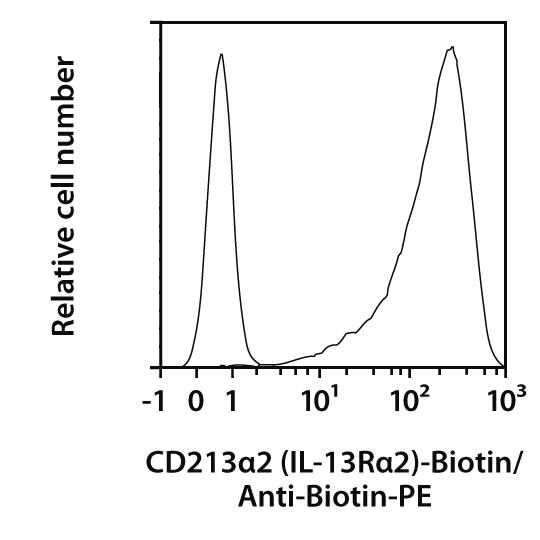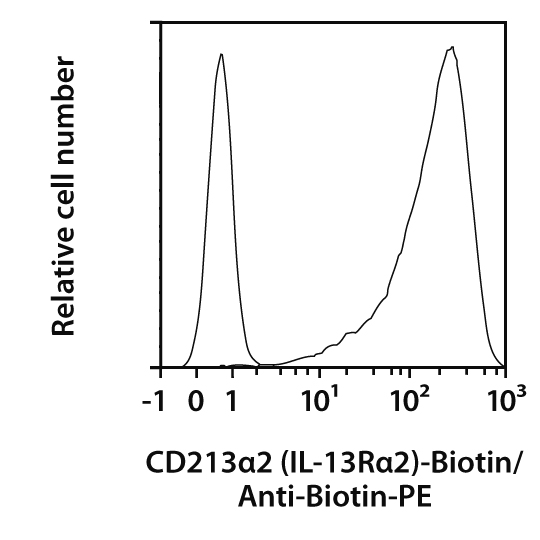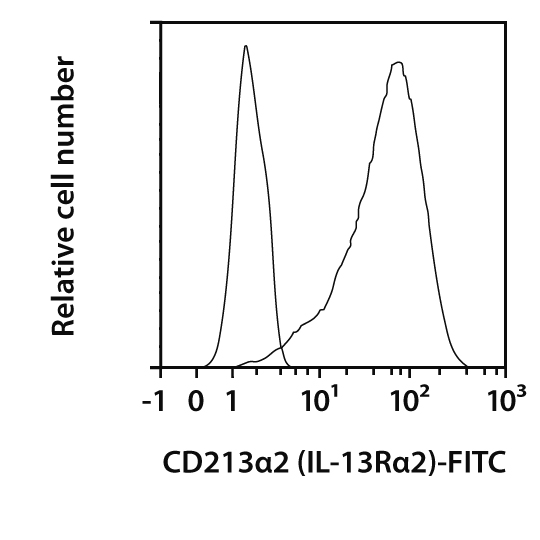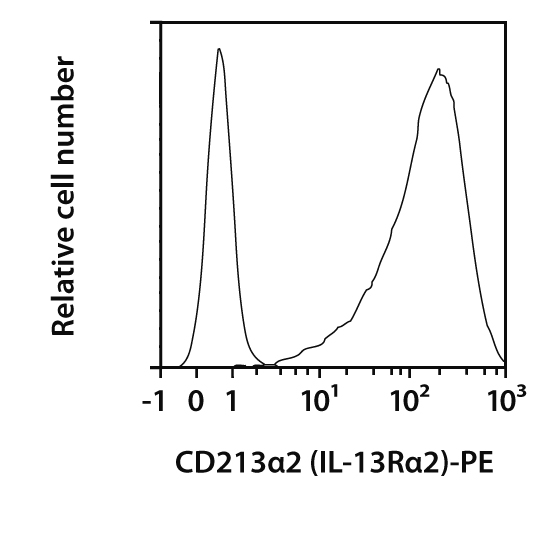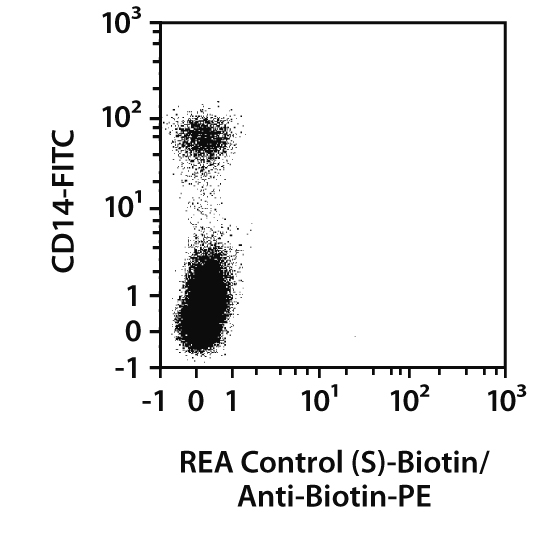Recombinant antibody
Code: 130-104-410
Overview
Clone REA295 recognizes the CD208 antigen, a single-pass type I intracellular protein also known as lysosome-associated membrane glycoprotein 3 (LAMP-3) or DC-lysosome–associated membrane glycoprotein (DC-LAMP). CD208 was first cloned as a gene specifically expressed in lung tissues and found to be overexpressed in primary cancers of the esophagus, colon, fallopian tube, ovary, breast, and liver, although its expression was barely detectable in the corresponding normal tissues. It is almost exclusively expressed by mature dendritic cells (DCs). Expression can be induced in CD34
+
derived dendritic cells by stimulation with GM-CSF and TNF-α or in monocytes by the stimulation with GM-CSF and IL-4. CD208 is found in the MHC class II compartment immediately before the translocation of MHC class II molecules to the cell surface, after which it concentrates into perinuclear lysosomes. This suggests that CD208 might change the lysosome function after the transfer of peptide-MHC class II molecules to the surface of DC.
Additional information: Clone REA295 displays negligible binding to Fc receptors.
Alternative names
LAMP3, DC LAMP, Protein TSC403Specifications
- Human : 0
- PE : 0
- 30 tests : 0
- 0.3 ml : 0
- Recombinant Human IgG1 : 0
Code: 130-104-503
Overview
Clone REA308 recognizes the human CD213α2 antigen, a single-pass type I membrane protein which is also known as interleukin-13 receptor subunit α-2 (IL-13Rα2). CD213α2 is a high affinity receptor for IL-13 that is used only by IL-13 and is quite distinct from CD213α1 (IL-13Rα1) that IL-13 shares with IL-4. CD213α2 is expressed by fibroblasts, smooth muscle cells, keratinocytes, and activated B cells. It has been thought to be a decoy receptor due to its short cytoplasmic tail and it exists on the cell membrane, intracellularly, and in soluble form. Recent reports revealed that membrane CD213α2 may have some signaling capabilities, and soluble CD213α2 is a critical endogenous modulator for IL-13 responses. Additionally, IL-13 signaling via CD213α2 plays a role in tumor immune surveillance.
Additional information: Clone REA308 displays negligible binding to Fc receptors.
Alternative names
IL13RA2, CD213A2, CT19, IL-13R, IL13BPSpecifications
- Human : 0
- Biotin : 0
- 100 tests : 0
- 1 mL : 0
- Recombinant Human IgG1 : 0
Code: 130-104-552
Overview
Clone REA308 recognizes the human CD213α2 antigen, a single-pass type I membrane protein which is also known as interleukin-13 receptor subunit α-2 (IL-13Rα2). CD213α2 is a high affinity receptor for IL-13 that is used only by IL-13 and is quite distinct from CD213α1 (IL-13Rα1) that IL-13 shares with IL-4. CD213α2 is expressed by fibroblasts, smooth muscle cells, keratinocytes, and activated B cells. It has been thought to be a decoy receptor due to its short cytoplasmic tail and it exists on the cell membrane, intracellularly, and in soluble form. Recent reports revealed that membrane CD213α2 may have some signaling capabilities, and soluble CD213α2 is a critical endogenous modulator for IL-13 responses. Additionally, IL-13 signaling via CD213α2 plays a role in tumor immune surveillance.
Additional information: Clone REA308 displays negligible binding to Fc receptors.
Alternative names
IL13RA2, CD213A2, CT19, IL-13R, IL13BPSpecifications
- Human : 0
- Biotin : 0
- 30 tests : 0
- 0.3 ml : 0
- Recombinant Human IgG1 : 0
Code: 130-104-598
Overview
Clone REA308 recognizes the human CD213α2 antigen, a single-pass type I membrane protein which is also known as interleukin-13 receptor subunit α-2 (IL-13Rα2). CD213α2 is a high affinity receptor for IL-13 that is used only by IL-13 and is quite distinct from CD213α1 (IL-13Rα1) that IL-13 shares with IL-4. CD213α2 is expressed by fibroblasts, smooth muscle cells, keratinocytes, and activated B cells. It has been thought to be a decoy receptor due to its short cytoplasmic tail and it exists on the cell membrane, intracellularly, and in soluble form. Recent reports revealed that membrane CD213α2 may have some signaling capabilities, and soluble CD213α2 is a critical endogenous modulator for IL-13 responses. Additionally, IL-13 signaling via CD213α2 plays a role in tumor immune surveillance.
Additional information: Clone REA308 displays negligible binding to Fc receptors.
Alternative names
IL13RA2, CD213A2, CT19, IL-13R, IL13BPSpecifications
- Human : 0
- FITC : 0
- 100 tests : 0
- 1 mL : 0
- Recombinant Human IgG1 : 0
Code: 130-104-670
Overview
Clone REA308 recognizes the human CD213α2 antigen, a single-pass type I membrane protein which is also known as interleukin-13 receptor subunit α-2 (IL-13Rα2). CD213α2 is a high affinity receptor for IL-13 that is used only by IL-13 and is quite distinct from CD213α1 (IL-13Rα1) that IL-13 shares with IL-4. CD213α2 is expressed by fibroblasts, smooth muscle cells, keratinocytes, and activated B cells. It has been thought to be a decoy receptor due to its short cytoplasmic tail and it exists on the cell membrane, intracellularly, and in soluble form. Recent reports revealed that membrane CD213α2 may have some signaling capabilities, and soluble CD213α2 is a critical endogenous modulator for IL-13 responses. Additionally, IL-13 signaling via CD213α2 plays a role in tumor immune surveillance.
Additional information: Clone REA308 displays negligible binding to Fc receptors.
Alternative names
IL13RA2, CD213A2, CT19, IL-13R, IL13BPSpecifications
Code: 130-104-504
Overview
Clone REA308 recognizes the human CD213α2 antigen, a single-pass type I membrane protein which is also known as interleukin-13 receptor subunit α-2 (IL-13Rα2). CD213α2 is a high affinity receptor for IL-13 that is used only by IL-13 and is quite distinct from CD213α1 (IL-13Rα1) that IL-13 shares with IL-4. CD213α2 is expressed by fibroblasts, smooth muscle cells, keratinocytes, and activated B cells. It has been thought to be a decoy receptor due to its short cytoplasmic tail and it exists on the cell membrane, intracellularly, and in soluble form. Recent reports revealed that membrane CD213α2 may have some signaling capabilities, and soluble CD213α2 is a critical endogenous modulator for IL-13 responses. Additionally, IL-13 signaling via CD213α2 plays a role in tumor immune surveillance.
Additional information: Clone REA308 displays negligible binding to Fc receptors.
Alternative names
IL13RA2, CD213A2, CT19, IL-13R, IL13BPSpecifications
- Human : 0
- PE : 0
- 100 tests : 0
- 1 mL : 0
- Recombinant Human IgG1 : 0
Code: 130-104-553
Overview
Clone REA308 recognizes the human CD213α2 antigen, a single-pass type I membrane protein which is also known as interleukin-13 receptor subunit α-2 (IL-13Rα2). CD213α2 is a high affinity receptor for IL-13 that is used only by IL-13 and is quite distinct from CD213α1 (IL-13Rα1) that IL-13 shares with IL-4. CD213α2 is expressed by fibroblasts, smooth muscle cells, keratinocytes, and activated B cells. It has been thought to be a decoy receptor due to its short cytoplasmic tail and it exists on the cell membrane, intracellularly, and in soluble form. Recent reports revealed that membrane CD213α2 may have some signaling capabilities, and soluble CD213α2 is a critical endogenous modulator for IL-13 responses. Additionally, IL-13 signaling via CD213α2 plays a role in tumor immune surveillance.
Additional information: Clone REA308 displays negligible binding to Fc receptors.
Alternative names
IL13RA2, CD213A2, CT19, IL-13R, IL13BPSpecifications
- Human : 0
- PE : 0
- 30 tests : 0
- 0.3 ml : 0
- Recombinant Human IgG1 : 0
Code: 130-104-581
Overview
Clone REA302 recognizes the human CD312 antigen, a multi-pass membrane protein also known as EGF-like module-containing mucin-like hormone receptor-like 2 (EMR2) which shares strikingly similar molecular characteristics with CD97. CD312 is a member of the epidermal growth factor-seven transmembrane (EGF-TM7) family of proteins expressed predominantly by cells of the immune system. CD312 fails to interact with CD55, the cellular ligand for CD97, suggesting the possibility of different cellular ligands. CD312 interacts with chondroitin sulphate glycosaminoglycans in an isoform-specific manner. Expression of CD312 is up-regulated during differentiation and maturation of macrophages, and is conversely down-regulated during dendritic cell maturation. In monocytes and macrophages, CD312 can be specifically up-regulated by LPS and interleukin 10 (IL-10) via an IL-10–mediated pathway. In inflamed tissues, CD312 is detected in subpopulations of myeloid cells including macrophages and neutrophils. CD312 plays a role in the migration and adhesion of myeloid cells during cell differentiation, maturation, and activation.
Additional information: Clone REA302 displays negligible binding to Fc receptors.
Alternative names
ADGRE2, EMR2Specifications
- Human : 0
- Biotin : 0
- 100 tests : 0
- 1 mL : 0
- Recombinant Human IgG1 : 0






